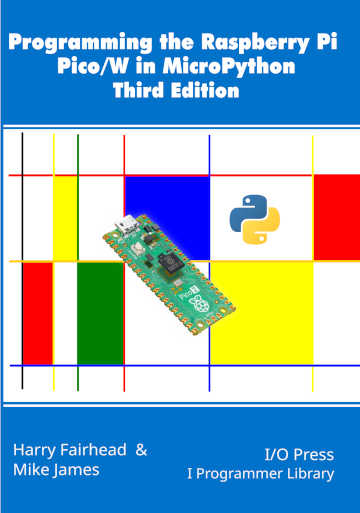Page 3 of 3
Complete Listing
import rp2
from machine import Pin
@rp2.asm_pio(set_init=(rp2.PIO.OUT_LOW,rp2.PIO.OUT_LOW),
autopush=True, in_shiftdir=rp2.PIO.SHIFT_LEFT)
def dht22():
wrap_target()
label("again")
pull(block)
set(pins, 0)
mov(x, osr)
label("loop1")
jmp(x_dec, "loop1")
set(pindirs, 0)
wait(1, pin, 0)
wait(0, pin, 0)
wait(1, pin, 0)
wait(0, pin, 0)
set(y, 31)
label("bits")
wait(1, pin, 0) [25]
in_(pins, 1)
wait(0, pin, 0)
jmp(y_dec, "bits")
set(y, 7)
label("check")
wait(1, pin, 0)[25]
set(pins,2)
set(pins,0)
in_(pins, 1)
wait(0, pin, 0)
jmp(y_dec, "check")
push(block)
wrap()
class DHT22():
def __init__(self, gpio):
self.sm = rp2.StateMachine(0, dht22, freq=490196,
Summary
The DHT22 is a low-cost temperature and humidity sensor.
It uses a custom single wire bus which is not compatible with the 1-Wire bus.
Its asynchronous protocol is easy to implement directly in user space.
A very simple checksum is used to detect errors.
It is possible to implement the protocol as defined in the datasheet using a PIO by using counting loops to time each pulse.
A better use of the PIO is to notice that the protocol can be decoded by testing the state of the line a fixed time after the rising edge.
Programming the Raspberry Pi Pico/W In MicroPython Third Edition
By Harry Fairhead & Mike James
Buy from Amazon .
Contents
Preface
Chapter 1 The Raspberry Pi Pico – Before We Begin
Chapter 2 Getting Started
Chapter 3 Getting Started With The GPIO
Chapter 4 Simple Output
Chapter 5 Some Electronics
Chapter 6 Simple InputSimple Input ****
Chapter 7 Advanced Input – Events and Interrupts
Chapter 8 Pulse Width ModulationPWM ****
Chapter 9 Controlling Motors And ServosDC Motors ****
Chapter 10 Getting Started With The SPI Bus
Chapter 11 A-To-D and The SPI Bus ****
Chapter 12 Using The I2C Bus
Chapter 13 Using The PIO
Chapter 14 The DHT22 Sensor Implementing A Custom ProtocolA PIO Driver For The DHT22 ****
Chapter 15 The 1‑Wire Bus And The DS1820
Chapter 16 The Serial Port
Chapter 17 Using The Pico W - WiFiHTTP Client ****
Chapter 18 Sockets Sockets ****
Chapter 19 Asyncio And ServersAsyncio Client ***NEW!!!
Chapter 20 Advanced Hardware
Chapter 21 Direct To The HardwareDirect To The Hardware ****
Also of interest:
Raspberry Pico File System
**** articles from the second edition not yet updated.
<ASIN:B0BR8LWYMZ>
<ASIN:B0BL1HS3QD>
To be informed about new articles on I Programmer, sign up for our weekly newsletter , subscribe to the RSS feed and follow us on Twitter, Facebook or Linkedin .
Google Tunix Hack Hackathon Now Open 14/11/2025
A Google hackathon on Kaggle is now open for entries showing how to use Tunix, Google's JAX-native library for LLM post-training, to train a model to show its work by laying out a reasoning trace befo [ ... ]
Kotlin 2.3 Improves Swift Interop 27/11/2025
Kotlin 2.3 is available now as a release candidate. The new version adds a new checker for unused return values, and changes to context-sensitive resolution. The release candidate adds support for Jav [ ... ]
More News
Comments
Make a Comment or View Existing Comments Using Disqus
or email your comment to: comments@i-programmer.info


